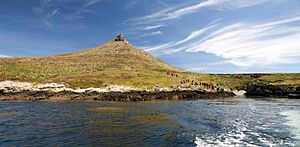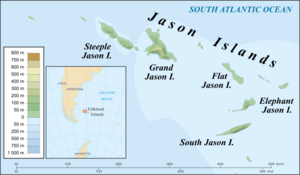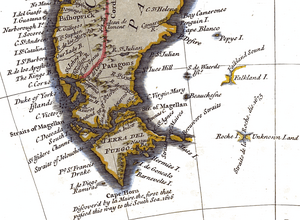Jason Islands facts for kids
The Jason Islands (called Islas Sebaldes in Spanish) are a group of islands in the Falkland Islands. They are located far to the north-west of West Falkland.
Three of these islands – Steeple Jason, Grand Jason, and Clarke's Islet – are special nature reserves. They are owned by the Wildlife Conservation Society from New York City. Other islands in the group are also National Nature Reserves, looked after by the Falkland Islands Government.
Contents
Exploring the Jason Islands: Geography
The Jason Islands group includes several islands. Some of the main ones are Steeple Island, Grand Island, Elephant Island, Flat Island, and South Island.
- Steeple Jason Island is long and narrow. It has two parts with steep slopes on both sides. The northern part has a wide, flat area. This area is very important for seabirds that come here to lay their eggs.
- Grand Island is the biggest island in the group. It has different types of land, like steep cliffs and high, flat areas with deep valleys. Some slopes are covered in tussac grass, which is a tall, tough grass. Other areas have been worn away, especially at the ends of the island. Higher up, there is less tussac grass, and you can find low grasses and small cushion plants.
- Steeple Islet is mostly low and slopes down to a rocky point. It is almost completely covered in thick tussac grass.
- Flat Jason Island is also low and flat.
- Elephant Jason Island has a long ridge that reaches about 208 meters (682 feet) high. The western coast has very steep cliffs. The northern and eastern coasts slope down to flat areas covered with thick tussac grass. This grass covers most of the island. In the early 1900s, this island was used by government workers who checked on sealing activities.
- South Jason Island has a central ridge with a high point of about 300 meters (984 feet).
- South Fur Island is about 3 miles (4.8 km) off the south coast of South Jason Island. It is known for its large, dark rocks called dolerite boulders.
- North Fur is east of Flat Jason. It has steep cliffs and has probably never been used for farming because it's hard to get to.
- Clarke's Islet is about 0.3 miles (0.5 km) off the north-eastern coast of Grand Jason Island.
- The Fridays are two small, low islands about 3 miles (4.8 km) off the north-west coast of Flat Jason.
The Spanish name for the whole group is Islas Sebaldes. Sometimes, the Spanish divide them into "Islas los Salvajes" (the western islands like Grand Jason and Steeple Jason) and "Islas las Llaves" (the eastern islands like Flat Jason). But in English, we just call them the "Jason Islands."
The Jason Islands have a unique look. One expert, Ian Strange, said their "sharply rising peaks give them a grandeur found in few other areas of the archipelago." This means they have a special, grand appearance compared to other islands nearby.
A Look Back: History of the Jason Islands
Islands in the Falklands region appeared on maps as early as the 1500s. This suggests that explorers like Ferdinand Magellan might have seen them. Amerigo Vespucci is also thought to have sighted the islands in 1502.
In 1519 or 1520, Estêvão Gomes, one of Magellan's captains, found several islands. His crew called them "Islas de Sansón y de los Patos" (Islands of Samson and of the Ducks). These were likely the Jason Islands.
On January 24, 1600, a Dutch explorer named Sebald De Weert saw some islands that weren't on his maps. He tried to land there but couldn't because of bad weather. These islands were the present-day Jason Islands. De Weert named them the "Sebald de Weert Eilanden." For many years, they were known as the Sebald Islands.
Since 1766, they have been officially called the "Jason Islands" in the Falklands and the British Empire. However, the name "Sebald Islands" (or "Islas Sebaldinas" in Spanish) was still used for a long time. Today, the name "Jason Islands" is used almost everywhere.
Between 1864 and 1866, a sad event happened. About two million rockhopper and gentoo penguins were killed on the Jason Islands. Their bodies were boiled to get their oil.
In March 1970, a man named Len Hill bought the islands for £5,500. He once printed special banknotes in the name of the islands. He did this to raise money for conservation efforts there. These notes were valid until December 31, 1979, and were signed by "Len Hill - Administrator."
In the 1990s, two of the Jason Islands, Steeple Jason and Grand Jason, were bought by New York helper Michael Steinhardt. He later gave them to the Bronx Zoo's Wildlife Conservation Society. He also gave them US$425,000 to build a research station named after him and his wife, Judy.
Who Lives There? Population of the Jason Islands
No one lives permanently on the Jason Islands today. However, people have lived there for short periods or during certain seasons.
In the 1920s, a police house was built. A police officer lived there to keep the islands safe. Their main job was to stop people from illegally hunting seals.
During the 1800s and 1900s, until the 1980s, some of the islands were used for grazing sheep and even some cattle. You can still see some old buildings from that time, like small houses and sheds for shearing sheep.
Today, some scientists live on the islands temporarily. They do research there. The Steinhart Station, built in 2003, is an important place for studying wildlife on Steeple Jason.
Amazing Animals: Wildlife of the Jason Islands
The Jason Islands are home to many interesting animals. You can find the striated caracara, different types of albatrosses, Antarctic skuas, and fur seals.
Important Bird Area: A Special Place for Birds
The Jason Islands group is recognized as an Important Bird Area (IBA) by BirdLife International. This means it's a very important place for bird conservation. Many birds that need protection live here.
Some of the important birds found here include:
- Falkland steamer ducks
- Ruddy-headed geese (about 10 breeding pairs)
- Gentoo penguins (around 12,000 pairs)
- Southern rockhopper penguins (a huge number, about 140,000 pairs!)
- Macaroni penguins (about 10 pairs)
- Magellanic penguins
- Black-browed albatrosses (around 210,000 pairs)
- Southern giant petrels (about 1,500 pairs)
- Striated caracaras (about 250 pairs)
- Blackish cinclodes
- Cobb's wrens
- White-bridled finches
Protecting Nature: Conservation Issues
From the late 1800s until about 1968, Steeple and Grand Jason islands had cattle and up to 5,000 sheep grazing on them. Too much grazing, called overgrazing, caused parts of these islands to become badly eroded. This means the soil was worn away. Elephant Jason also had sheep from 1967 to 1971.
Since then, the sheep have been removed. Now, the islands are managed as nature reserves to protect their natural environment. Fire has been a problem on South Jason. Also, Steeple Jason has an issue with mice. However, the good news is that the islands in the group are free of other animals that were brought in by humans and could harm the native wildlife.
The Jason Islands are now run as a nature reserve, helping to keep their unique wildlife safe.
See also
 In Spanish: Islas Sebaldes para niños
In Spanish: Islas Sebaldes para niños





